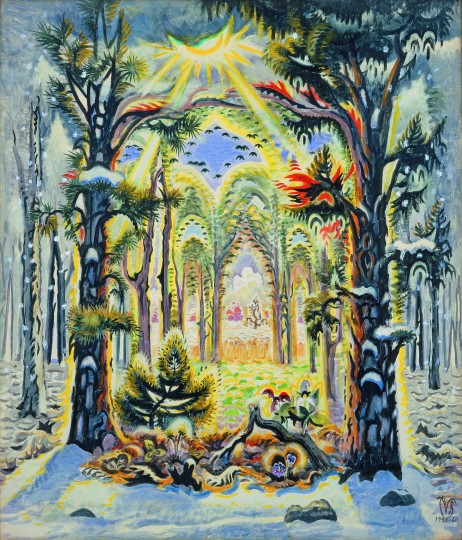by Mike Telin

On Saturday, November 18 at 8:00 pm in E.J. Thomas Hall, the Akron Symphony will present three works inspired by masterpieces of art: Eric Benjamin will conduct Morton Gould’s Burchfield Gallery, and Wilkins will lead Paul Hindemith’s Mathis der Maler and Modest Mussorgsky’s Pictures at an Exhibition. Tickets are available online.
The concert will also include projected visual images of the art that inspired the music. “Because showing a single image is a static thing to do, I think it’s more artistically honest to show and talk about the paintings and then perform the work,” Wilkins said. “In all three cases that is what we’re going to do.”
Born in Ashtabula, Ohio in 1893, Charles Burchfield graduated from the Cleveland Institute of Art in 1916. His impassioned, surreal, and ecstatic scenes inspired Morton Gould’s Burchfield Gallery, premiered by The Cleveland Orchestra in 1981 under the direction of Lorin Maazel. “I first heard it a few years ago and it’s an interesting work — Gould was incredibly adept at using the colors of the orchestra. Two of the five movements we’re performing are set to individual paintings. One of them, ‘The Four Seasons,’ is a fascinating painting in which the progression of the seasons moves from foreground to background” (shown above).
Wilkins noted that the piece has a direct family connection to the ASO. In an email to the conductor, principal horn Meghan Guegold wrote that Burchfield “was married to my great great grandpa’s sister, Bertha Kenreich [pronounced Ken-rye]. He spent time on the Kenreich family farm in Greenford, near Salem, Ohio, which my mom eventually grew up on and my uncle still owns.”
Wilkins said that he was not aware of Guegold’s relationship to Burchfield when he programmed the work. “When the season was announced she looked it up. She’s forwarded me photographs of the farm and family, so I will work it into my remarks.”
The painter later became famous for creating what was known as Burchfield wallpaper. Click to view images from the Burchfield/Penney Gallery at SUNY Buffalo click here.
With many orchestrations of Pictures to choose from, Wilkins finds Ravel’s to be the best. “There are people who say that it’s glorious but not very Russian. That may be true, although the connection between Paris and St. Petersburg in particular was incredibly strong during the first part of the 20th century. Think about Stravinsky’s presence in Paris and the influence of Russians on the development of French orchestral music, ballet, and opera. When you hear the piece played on piano, it suggests grand gestures of brass, and what Ravel did with those is incredibly insightful. He knew how to get an orchestra of whatever size to sound magnificent.”
It was the Isenheim Altarpiece, Matthias Grünewald’s Renaissance triptych on themes of temptation and healing, that served as inspiration for Hindemith’s Mathis der Maler. “A lot of people think of Hindemith as being technically impressive but a little dry and emotionally detached,” Wilkins said. “But I find Mathis to be profoundly rich. The altarpiece itself is one of the most overwhelmingly powerful works in Western art. It’s arresting, visually impressive, and filled with fantasy and allegory.”
Published on ClevelandClassical.com November 14, 2017.
Click here for a printable copy of this article



